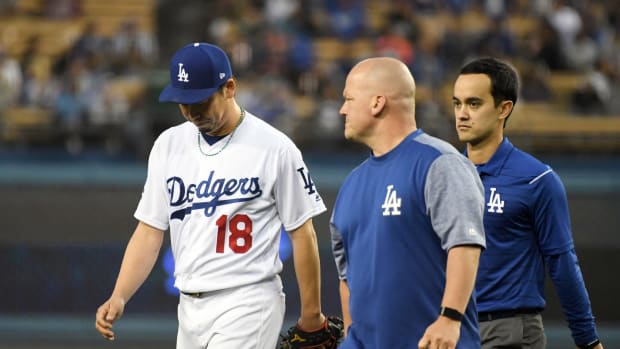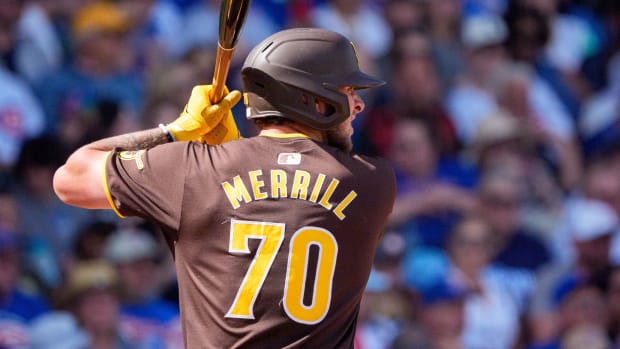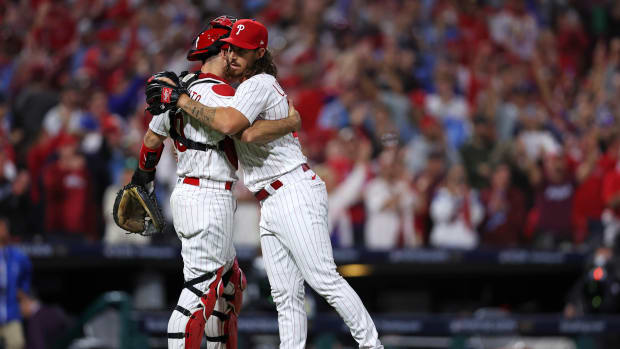Dodgers’ Decade-Long Pursuit of Shohei Ohtani Finally Comes Through
When Shohei Ohtani visited the Dodgers on Dec. 1, he made a point of asking the club about its player development philosophy and the state of its minor league system. Los Angeles was ranked by MLB.com midway through the 2023 season as having the sixth-best system in baseball. The Blue Jays, who were next on Ohtani’s limited free-agent tour, checked in at No. 25.
Why ask about the minor leagues? If Ohtani was signing on for the next decade or more, he wanted to know if the success of his next team would be sustainable. He had just spent six years with the Angels finishing 10 games or more out of the playoffs every year.
Dodgers personnel felt good about the meeting. If, they figured, Ohtani wanted sustained success—the possibility of postseason baseball every year—they saw themselves as the better option over Toronto. The Dodgers have reached the postseason 11 straight seasons, including three World Series appearances. They have never played a meaningless game in this run. The Blue Jays have reached the playoffs five times in those 11 seasons and have not won a pennant since 1993.
“It’s refreshing,” said one high-ranking Dodger source at the time, “that it seems he really is putting comfort level above going after every last dollar. It doesn’t appear that he regards the best deal as the most money. And if he is looking for the most chances in the playoffs over the next 10 years, then we have the obvious advantage on Toronto just by track record.”
In the end, of course, it is always about money—and in this case more than any ever handed to an athlete: $700 million over 10 years. But it was Ohtani who told his agent, Nez Balelo, to craft a deal with so much deferred money that it would reduce the Dodgers’ hit toward their competitive tax rate.
In that way, Ohtani told his agent, the contract would not prevent the Dodgers from continuing to compete for the postseason every year. Ohtani suggested he defer more than half the $700 million at below-market interest rates. The math still needs to be done by the commissioner’s office and the players association, but the annual present-day value against the CBT could be about $50 million at the lowest, but probably higher, according to a rival club executive.
The contract numbers solve two needs: Balelo and Ohtani get the bragging rights of leapfrogging Lionel Messi for the largest contract signed by an athlete, and the Dodgers get a player for about $50 million a year who can return as much as $25 million a year in ancillary income and brand value, according to the owner of a rival team.
“It ends up like a lot of these high-profile deals,” says an executive from a team in the early Ohtani sweepstakes. “The final number is the bright, shiny object. It’s how you get to those numbers—the details of it—that matter.
“This is where everybody thought it was going to wind up all along. The Dodgers were into him since high school. It’s the same city [as the Angels]. Teams felt all along they did not want to play the role of the stalking horse. The Dodgers’ M.O. has always been that they don’t move until they have to. I guess the ‘plane ride’ worked.”

After signing the biggest contract in sports history, Ohtani joins a Dodgers franchise that has pursued him for more than a decade.
Jayne Kamin-Oncea/USA TODAY Sports
On Friday, reports broke that Ohtani’s signing was imminent and that he was headed to Toronto to sign with the Blue Jays. The report was completely erroneous. The Dodgers didn’t know that. They held meetings Friday night with an air of worry. The rumors were likely false, they decided, but they still created angst among the Los Angeles executives.
“You just don’t know,” says one of the Dodger executives when asked about the Friday night meeting. “That’s the best way to describe it. We just didn’t know. It was not a comfortable feeling.”
The Dodgers had been trying to sign Ohtani for a decade. They missed out on him in 2012 when he signed with the Nippon Ham Fighters. They missed out on him in ’17 when the National League had no DH, and he signed with the Angels. The Dodgers had spent the past 15 months clearing payroll space specifically to make a run at Ohtani.
As much as the Dodgers coveted Ohtani the player, they fell in love with Ohtani the person when he visited Dodger Stadium last week. Besides asking about the minor league system, Ohtani talked about how much he loves baseball and he talked about his dog. At one point, according to a source, he even remarked how the money that was in play “was laughable to even think about.” As colleagues say, Ohtani has two pastimes: playing baseball and training for baseball.
“We were blown away,” says one Dodgers executive. “It was refreshing. He seems even younger than his age because he has this youthful love for the game. We wanted to know what motivates him and it was just so simple: to play baseball. Some guys want to come off as a CEO or a brand. Shohei was just so refreshing. I know we left that meeting feeling even better about signing him.”
The baseball ops people wanted Ohtani for his bat, knowing his pitching career may or may not resume at an elite level in 2025 when he is recovered from a second Tommy John surgery. The business side never blinked. Even though the Dodgers nearly max out on ticket sales, which blunts his effect at the gate, the team knows Ohtani is the only baseball player with an international brand. Mark Walter, owner and chairman, did not have to be convinced. He was all in. Walter’s various businesses, including media, entertainment and financial services, include footholds in Japan.
“He sees the economic impact,” says a Dodgers source. “The Dodgers are an international brand. Put it this way, the brand is bigger today than it was yesterday.”
And they are not done. The Dodgers, according to a team source, are still forging ahead to try to sign free-agent pitcher Yoshinobu Yamamoto and/or Rōki Sasaki if he is posted and made a free agent out of Japan. The Dodgers already explored how Ohtani felt about sharing the stage with his fellow WBC teammates (he’s fine with them). Their manager on that team was Hideki Kuriyama.
To understand why Ohtani was the greatest free agent in sports history, you must go back to Kuriyama, the most influential man in the arc of his baseball career. As a high school senior in 2012, Ohtani threw 99 miles an hour and was courted heavily by the Dodgers, Red Sox, Orioles and Rangers. He was so certain he would sign with an MLB team that he asked the teams in Nippon Pro Baseball not to draft him.
Kuriyama had other ideas. The manager of the Nippon Ham Fighters in Sapporo is a traditional baseball man with outside-the-box ideas—sort of the Joe Maddon of Japan. The Fighters drafted Ohtani with the first pick. Kuriyama wore a purple outfit for good luck, purple being the color of Ohtani’s high school.
“When they first selected me,” Ohtani said then, “there was zero chance of me signing with them.”
And then Kuriyama and the Fighters’ front office went to work.
On Nov. 26 at their first meeting, Kuriyama gave Ohtani a black T-shirt with birds in full flight and the message, “Dreams Come True.” (He also wore a purple scarf and purple underwear for good luck.) He carried a 30-page document prepared by the front office that outlined the difficulty of Asian athletes heading overseas out of high school, including a pitcher from Korea signed by the Rangers who was done at age 23 without ever reaching the majors. It was titled, “The Path to Realizing Shohei Ohtani’s Dream.”
Most importantly, Kuriyama convinced Ohtani to both hit and pitch for the Fighters—the manager considered him such a special athlete he planned to work out Ohtani at shortstop.
That was the dream to which the T-shirt referred: the dream, as Kuriyama put it, to “walk a path no one else” dared travel.
Ohtani signed with the Fighters. Kuriyama wore beige to the last meeting that clinched the deal in honor of the Ohtani family dog, Ace, according to reports in Japan. One hundred fifty people attended his news conference on Christmas Day. Asked to explain his decision, Ohtani said it was in great part because Kuriyama had challenged him.
“He told me that he wanted me to travel down a path no one else walked down,” Ohtani said then. “I would like to become the kind of player that can do that.
“The materials they provided contained things I did not know. At first, I did not consider the option of being a hitter and pitcher.”
Ohtani so developed his bona fides as a two-way player in Japan—the fear was an MLB team would push him to specialize—that when he did come to America, he could demand he continue to hit and pitch as a two-way player. With the Angels, he sustained his dual greatness longer than his only true comp, Babe Ruth.

Since 2021, Ohtani has hit the fourth-most homers (124) and tallied the third-lowest ERA (2.84), winning two American League MVP awards in the process.
Kohjiro Kinno/Sports Illustrated
In the past three seasons, he has been the best player in baseball in an unprecedented run of versatility of the highest order: a premier slugger (only Aaron Judge has a higher slugging percentage), runner (only Amed Rosario has more triples) and pitcher (only Max Fried and Max Scherzer have a lower ERA over at least 400 innings).
The future of his dual mastery, however, is in question. Ohtani underwent Tommy John surgery last October for the second time in five years. He will not pitch in 2024. The question is, if and when he returns to the mound in ’25, what kind of pitcher will he be? How long can he withstand the physical toll?
“As he gets three, four, five years into the contract, the odds of him dominating as a pitcher decrease dramatically,” says the executive of one team. “Even pitching at all becomes a question. If that’s the case, he has to play the outfield because you don’t want one guy taking up the DH spot. He hasn’t played the outfield in quite a while, but I’m sure he could do it if he had to.”
The message that was on that T-shirt 11 years ago, “Dreams Come True,” seems appropriate to remember today. The dream was never $700 million, a number even Ohtani finds “laughable.” The dream was to become a two-way player. And then it was to become the best player in the world. It has evolved again: the dream is to play nothing but meaningful games for the next decade with the Dodgers and, of course, win a championship.
“There is only one player in a lifetime like this,” says one Dodger executive. “So when you have the one chance to sign Shohei Ohtani you do what you can.”
Says another Dodger executive, “There are very few true global superstars in the world of sports. There is only one when it comes to baseball.”
More MLB Coverage:
Stephanie Apstein & Emma Baccellieri: Shohei Ohtani’s Deal Is a Big Loss for These Five Teams
Stephanie Apstein: Shohei Ohtani’s Greatness Finally Has a Price: $700 Million
Emma Baccellieri: Shohei Ohtani’s Free Agency Descends Into Delightful Display of Chaos



































